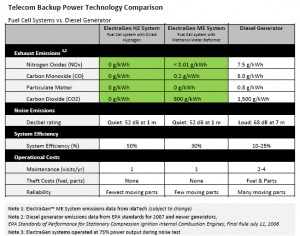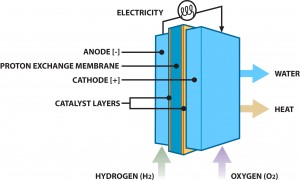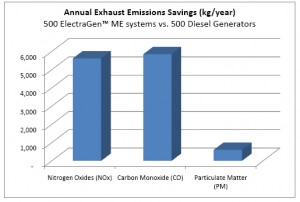Kathy Fosberg, Marketing Communications Manager, IdaTech LLC
As companies around the world are increasingly focused on reducing their carbon footprints, fuel cell technology is helping mobile network operators meet both sustainability and business goals. Driven by high energy costs, limited access to electricity in many developing countries, increased legislation and market pressure, network operators are more frequently choosing clean technology solutions for their backup power needs over traditional options. Clean and energy efficient fuel cells can help reduce CO2 emissions by 50 percent as well as decrease other toxic emissions and deliver additional environmental and efficiency benefits, making them more often the first choice for telecom carriers today.
A Clean Alternative
 With society’s reliance on mobile networks to power smart communications devices, having backup power at base station sites is critical in the event of power loss from severe weather, natural disasters or limited grid capacity.
With society’s reliance on mobile networks to power smart communications devices, having backup power at base station sites is critical in the event of power loss from severe weather, natural disasters or limited grid capacity.
Traditional telecom backup power solutions include VRLA battery strings for short duration backup, and diesel and propane generators for longer duration backup. Batteries are relatively inexpensive for one to two hours of backup power. However, batteries are not ideal for longer duration backup power applications because they can be expensive to maintain, unreliable after aging, temperature sensitive and hazardous to the environment after disposal.
Diesel and propane generators are capable of longer duration backup power. While diesel generators are popular primarily due to their relatively low initial cost; unreliable operation for diesel generators is common, and operating costs are high due to poor efficiency and high service costs. Their environmental impact is significant due to their high emissions, low efficiency and loud operation.
Fuel cells offer improved system reliability, more predictable performance in a broad range of climates and a reliable service life when compared to battery strings and diesel generators.
Lower fuel cell operating costs are the result of only one maintenance visit per year and significantly higher system efficiency. Fuel cells also offer environmental and economical advantages to end users because disposal costs and liability risks related to lead acid batteries are an increasing concern. In California, for example, telecom sites with more than 500 pounds of lead acid batteries or one gallon of acid face fees from the state.
How Fuel Cells Work
A fuel cell is a solid-state DC power generator that converts chemical energy into electricity. Hydrogen and oxygen (air) are the two fuels of that reaction. One great appeal of fuel cells is that they generate electricity with zero pollution; hydrogen and oxygen are combined to generate electricity, with water and heat as the only by-products.
The system continuously senses the direct current (DC) bus voltage and seamlessly takes over critical loads if the DC bus falls below a customer-determined set point. The system is fueled by hydrogen, which is delivered to the fuel cell stack in one of two ways: either from a commercial-grade hydrogen supply or a methanol and water liquid fuel, using an integrated reformer system.
 Electricity is generated by the fuel cell stack as direct current. The DC energy is passed to a DC/DC converter, which converts the unregulated DC electricity from the fuel cell stack into high-quality regulated DC electricity to serve the required loads. Fuel cell systems can provide multiple days of backup power since run time is limited only by the amount of hydrogen or methanol-water fuel stored on site.
Electricity is generated by the fuel cell stack as direct current. The DC energy is passed to a DC/DC converter, which converts the unregulated DC electricity from the fuel cell stack into high-quality regulated DC electricity to serve the required loads. Fuel cell systems can provide multiple days of backup power since run time is limited only by the amount of hydrogen or methanol-water fuel stored on site.
Eliminating Emissions
Fuel cells can virtually eliminate the two most highly toxic emissions of diesel generators: nitrogen oxides (NOx) and sulphur oxides (SOx), which together are the main causes of acid rain and also contribute to the ozone formation in the air and ground.
 Network operators who choose a methanol-water fuel cell system over a traditional diesel generator can realize significant exhaust emissions savings of a 50 percent reduction in CO2 emissions and more than a 95 percent reduction in CO, nitrogen oxide and sulphur oxide emissions. Unlike methanol, diesel generators also produce particles and un-reacted heavy hydrocarbons.
Network operators who choose a methanol-water fuel cell system over a traditional diesel generator can realize significant exhaust emissions savings of a 50 percent reduction in CO2 emissions and more than a 95 percent reduction in CO, nitrogen oxide and sulphur oxide emissions. Unlike methanol, diesel generators also produce particles and un-reacted heavy hydrocarbons.
Increased Efficiency
Fuel cell systems can be more than twice as efficient at producing electricity than internal combustion engines such as diesel and LPG generators. Increased efficiency reduces fuel consumption and lowers operating costs. Furthermore, a more efficient system produces fewer exhaust emissions, lowering the impact on the environment.
Fuel cell systems are quieter and have significantly less vibration than diesel generators. Quiet operation is highly valued in areas where people live and sleep and can result in a lower incidence of vandalism.
Other Green Benefits
A fuel cell stack consists of graphite plates and polymers, whereas VRLA batteries include materials harmful to the environment and are difficult to dispose. Fuel cell stacks are recyclable, and refurbished (replacement) fuel cell stacks are available.
 Another benefit is that fuel cells require less air conditioning. In tropical environments, telecom cabinets and shelters are typically cooled using traditional AC air-conditioning units. Typical VRLA batteries are required to be maintained at temperatures around 22°C (± 2°C), in order to avoid rapid degradation.
Another benefit is that fuel cells require less air conditioning. In tropical environments, telecom cabinets and shelters are typically cooled using traditional AC air-conditioning units. Typical VRLA batteries are required to be maintained at temperatures around 22°C (± 2°C), in order to avoid rapid degradation.
However, most telecom transmission equipment can operate at temperatures up to 35°C to 40°C without any deterioration or performance degradation. By removing batteries from the shelter, a more efficient cabinet cooling method can be used such as DC air-cooling systems.
New-generation DC air-cooling systems offer improved efficiency and performance for telecom sites. Backup power fuel cell systems operate at temperatures up to 46°C and do not require air conditioning. Reducing batteries at a telecom site and adding a fuel cell system will relax the temperature cooling requirements and will lower operating costs.
Renewable Fuel Possibilities
Fuel cell systems that run on methanol-water can also use a renewable fuel, a combination of bio-methanol and water. Bio-methanol can be produced from synthesis gas, derived from biomass feedstocks, such as wood waste. A fuel cell system powered by a renewable fuel has a very low impact on the environment.
Government rebate programs are available for telecom carriers to buy fuel cell systems at a substantially discounted price. In California, federal and state incentives for implementing a system that uses bio-methanol renewable fuel can potentially offset the entire system purchase price. New Jersey, Oregon and Tennessee also offer state rebate incentives. In addition, all states are eligible for 30 percent federal cash rebate for installing fuel cell systems.
As our society continues to increase its reliance on wireless technologies and also its commitment to protecting the planet, backup power fuel cell systems will present clean technology solutions that lower operating costs, improve network reliability and benefit the environment.
Kathy Fosberg is marketing communications manager at IdaTech, LLC. For more information, please e-mail kfosberg@idatech.com or visit www.idatech.com.
This article was printed in May/June 2011 issue of Battery Power magazine.







